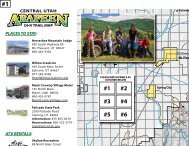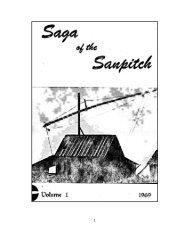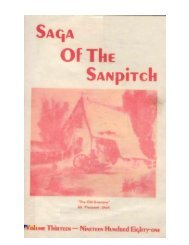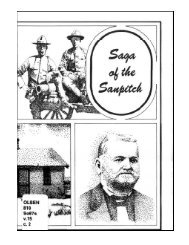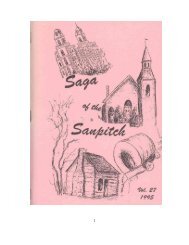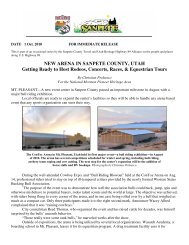Saga of the Sanpitch Volume 17, 1985 - Sanpete County
Saga of the Sanpitch Volume 17, 1985 - Sanpete County
Saga of the Sanpitch Volume 17, 1985 - Sanpete County
You also want an ePaper? Increase the reach of your titles
YUMPU automatically turns print PDFs into web optimized ePapers that Google loves.
prisoners, but also <strong>the</strong> invited guests. Boasting <strong>of</strong> <strong>the</strong>ir feats in arms, <strong>the</strong>ir prowess in battle, and <strong>the</strong>ir power<br />
to destroy whom <strong>the</strong>y would, <strong>the</strong> arrogant savages spoke with contempt <strong>of</strong> <strong>the</strong> weak, unprotected<br />
settlement, threatening to destroy it as <strong>the</strong>y had done Shoshone villages.<br />
The settlers were saved from this threatened destruction by <strong>the</strong> wisdom <strong>of</strong> Brigham Young, for <strong>the</strong><br />
leaders <strong>of</strong> <strong>the</strong> victorious Utes remembered that <strong>the</strong> great white leader had not made war upon <strong>the</strong>m. His<br />
people had fed <strong>the</strong>m and treated <strong>the</strong>m with kindness, Because <strong>of</strong> this policy, <strong>the</strong> hints <strong>of</strong> torture and threats<br />
<strong>of</strong> annihilation thrown out by <strong>the</strong> proud chief and his men were not carried out. The danger, however, <strong>of</strong> an<br />
assault by this howling band <strong>of</strong> savages was still present, and threatened to flare up at <strong>the</strong> least provocation.<br />
To protect <strong>the</strong>mselves from an attack which might come at any moment, night or day, <strong>the</strong> pioneers decided<br />
to build a fort. But <strong>of</strong> what? They were surrounded now, not by weak <strong>Sanpitch</strong>es, but by powerful Utes. To<br />
procure logs from <strong>the</strong> higher elevations, <strong>the</strong> men would have to leave <strong>the</strong>ir homes unguarded for long hours<br />
and subject <strong>the</strong>mselves to <strong>the</strong> dangers <strong>of</strong> being ambushed and slain. The dilemma in which <strong>the</strong>y found <strong>the</strong>mselves<br />
was indeed serious.<br />
While debating <strong>the</strong> problems <strong>of</strong> constructing a fort, one <strong>of</strong> <strong>the</strong> men suggested that stone from <strong>the</strong> gray<br />
hill might be used to build <strong>the</strong> walls. This idea was well received. The stone was <strong>of</strong> good quality and nearby,<br />
and <strong>the</strong> men could guard <strong>the</strong>ir homes while at work on <strong>the</strong> fort. The suggestion was acted upon immediately,<br />
and soon <strong>the</strong> men were at work quarrying. Within a very short time, a strong stone fort, <strong>the</strong> walls <strong>of</strong> which<br />
were eight feet high and two feet thick, had been built. Later in <strong>the</strong> summer <strong>of</strong> 1854 a bigger and stronger<br />
fort was built <strong>of</strong> stone, and in l866, when Chief Blackhawk went on <strong>the</strong> warpath, a stone fort was built around<br />
<strong>the</strong> Tabernacle Block in Manti. These forts, built <strong>of</strong> stone from <strong>the</strong> gray hill, protected <strong>the</strong> settlement from<br />
destruction by hostile Indians from <strong>the</strong> beginning <strong>of</strong> <strong>the</strong> Walker War in 1852 until <strong>the</strong> close <strong>of</strong> <strong>the</strong> Blackhawk<br />
War in 1867.<br />
In view <strong>of</strong> <strong>the</strong> fact that serious trouble developed with <strong>the</strong> Indians, <strong>the</strong> pioneers were thankful <strong>the</strong>y<br />
had made <strong>the</strong>ir settlement near <strong>the</strong> gray hill as advised by <strong>the</strong>ir leader. They believed <strong>the</strong> forts constructed <strong>of</strong><br />
stone from <strong>the</strong> lowly mountain had saved <strong>the</strong>ir lives, and that <strong>the</strong> inspired leadership <strong>of</strong> Brigham Young had<br />
been vindicated.<br />
During this early period <strong>the</strong> value <strong>of</strong> <strong>the</strong> gray hill as a source <strong>of</strong> fine building stone became known<br />
throughout <strong>the</strong> country. From its well stratified and evenly bedded deposits <strong>of</strong> Oolite stone, beautiful creamcolored<br />
blocks were cut, not only for private and public buildings in Manti, but for some <strong>of</strong> <strong>the</strong> more pretentious<br />
residences in Salt Lake City. Into <strong>the</strong> magnificent Salt Lake Temple went two large tablets <strong>of</strong> this<br />
stone, and in <strong>the</strong> year 1852, William Ward, a sculptor, carved a block <strong>of</strong> it for <strong>the</strong> Washington Monument. As<br />
<strong>the</strong> valuable deposit <strong>of</strong> Oolite stone was developed, <strong>the</strong> gray hill assumed added importance, and became<br />
known as <strong>the</strong> Manti Stone Quarry.<br />
Source: THE MIRACLE OF THE MOUNTAINS by William H. Peterson, 1942, pp. 6-15.<br />
79



